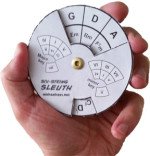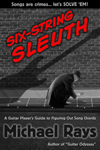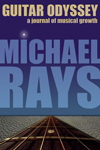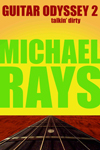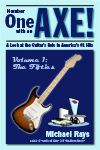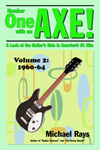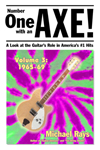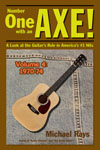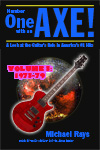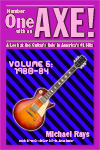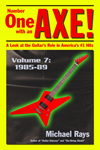When Guitar Met Pop Music…
Pop music history for GUITAR fanatics! Share on X“Number One with an AXE!” sells for $2.99 and is available at:
smashwords, amazon, kobo, iBooks, barnes & noble.

“Number One with an AXE! A Look at the Guitar’s Role in America’s #1 Hits” $2.99
July, 2016
The guitar’s pre-eminence in rock & roll is well-known–but what about pop music? Specifically, what about Number One hits? Guitar gadfly and pop music lover Michael Rays takes you on a guitar-oriented tour through the history of Billboard’s American Number One hits, starting in 1955 with “Rock Around the Clock” and proceeding through Frankie Avalon’s “Why”–the final #1 song of 1959. Rays rates each song on four guitar-centric criteria: Riffage, Rhythm Playing, Fills and Solos. He also writes a brief commentary on each song, noting the many strummed surprises, oddities and innovations that enriched the American soundtrack of the late 50s. This book is about great music, great memories, and great (and occasionally not-so-great) guitar!
Excerpts…
Heartbreak Hotel, Elvis Presley, 4/21/56, 8 weeks at #1
Riffage 0, Rhythm 4, Fills 7, Solo 3; Total 14
NOW we’re talkin’! This rock classic boasts Scotty Moore and Chet Atkins, as well as Floyd Cramer on piano—what a lineup! You’ve heard it a thousand times, but give it a fresh listen with headphones and check out the subtle guitar fills. (Moore or Atkins? It sounds like Chet to me. There are also some nice, not-so-subtle piano fills by Floyd Cramer.) The guitar solo (which I’m guessing is Moore) is good but really only half a solo; Cramer takes over for the second half.
Innovation Alert! This is the first song on the list to use guitar fills.
Tequila, The Champs, 3/17/58, 5 weeks at #1
Riffage 9, Rhythm 9, Fills 0, Solo 0; Total 18
The riff is the rhythm and the rhythm is the riff. The Champs deserve the widespread and enduring fame they gained from this inspired song. Hopefully you know all the words!
Innovation Alert! While “Heartbreak Hotel” features two guitar players, “Tequila” takes the dynamic further: the chord riff and inventive rhythm lines are designed to interlock, thus creating (with the drums and bass, both par excellence) one of the great grooves in all of pop music.
The Battle of New Orleans, Johnny Horton, 6/1/59, 6 weeks at #1
Riffage 8, Rhythm 7, Fills 0, Solo 0; Total 15
Johnny isn’t whistling Dixie: he’s playing it on his banjo! (It may not actually be Johnny himself, but you get the idea.) So begins the biggest number one song in all of 1959. The banjo continues with a nice rhythm line throughout the song.
Note: Like many guitar players, I hold the view that the only difference between a banjo and a trampoline is that you take off your shoes to jump on a trampoline. HOWEVER for this project, where many songs feature little or no guitar at all, I’m going with a “big-tent” policy regarding banjo, ukulele, etc. Thank you for your understanding.

